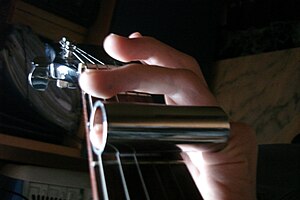 |
| A "slide" being used on a guitar (Photo credit: Wikipedia) |
There are number of choices for you to chose your slide and set-up for your guitar. Also, there is no such standard rule that you need to confirm while adjusting the chords on your guitar slide. Most of the people generally prefer heavier strings as well as higher action.
Hold your guitar slide in such a way that fits your fingers the best. This will help you in playing your guitar chords and lyrics in a very convenient manner. Make sure that the slide should fit your finger snugly enough to keep it from falling on your toe when you relax your hand at your side with the fingers placed straight down. This will enable you in keeping your hand muscles from having to hold the slide in place on your finger, freeing them to play the country guitar chords, which after all is the your ultimate goal.
After that choose the finger which is most suitable and comfortable for playing your tunes. To maintain the maximum flexibility and usefulness, it is generally suggested to learn to play with your slide with the help of your little finger. With such a type of placement the three three adjacent fingers are left free to play figures behind the slide and for chords leaving the slide out of the way.
You will also find guitarists who play around the slide by wearing on his ring finger, and developing his or her own style around that. Some people wear their slide like a Mateus wine bottle neck on their ‘redneck salute’ finger, which really does limit what they can do with their fingers.
While chords are primarily used for rhythm guitar, basic chord knowledge can be important for lead playing as well. Knowing how chords are constructed can help when learning the lead parts of many songs since there is always a relationship between a chord and the lead part.


